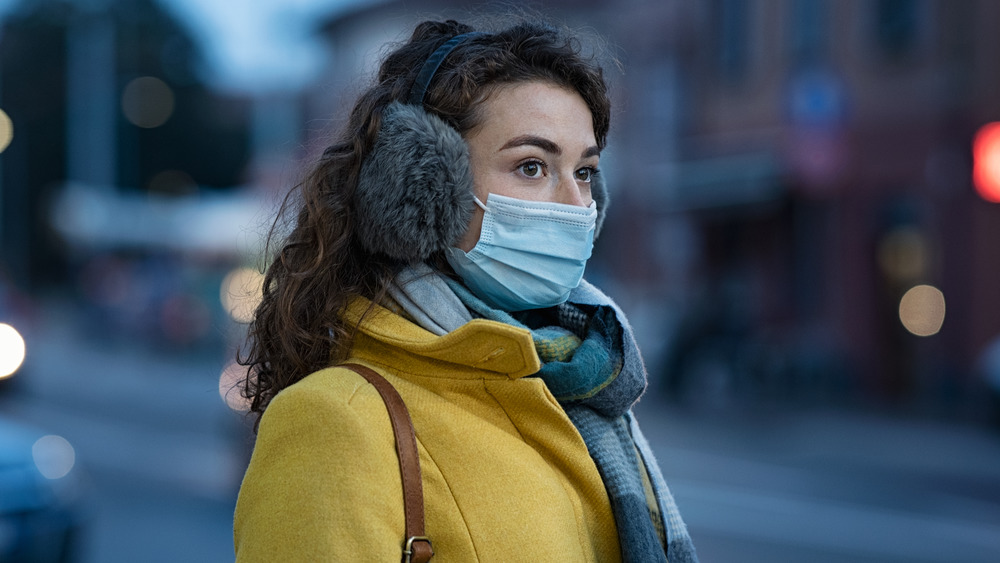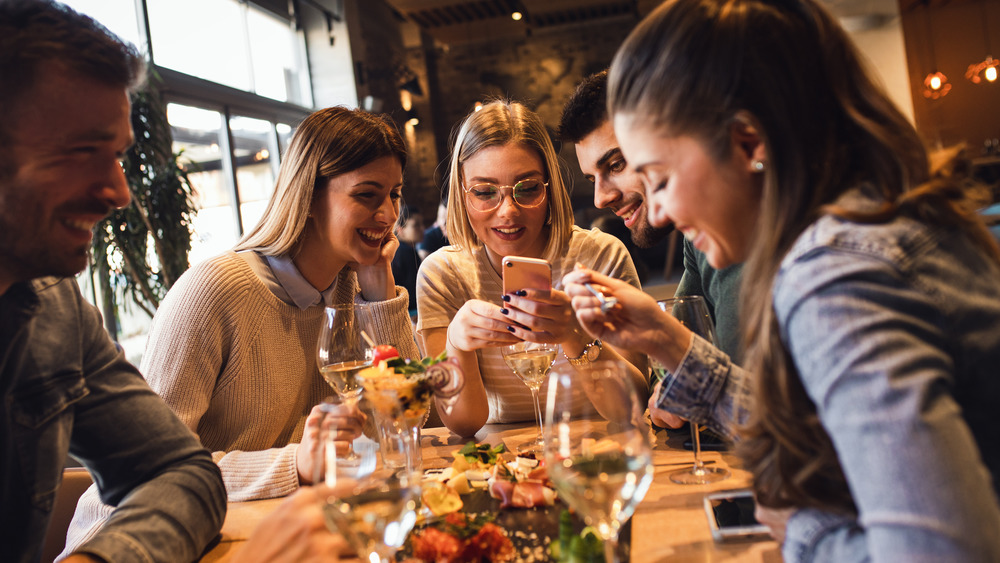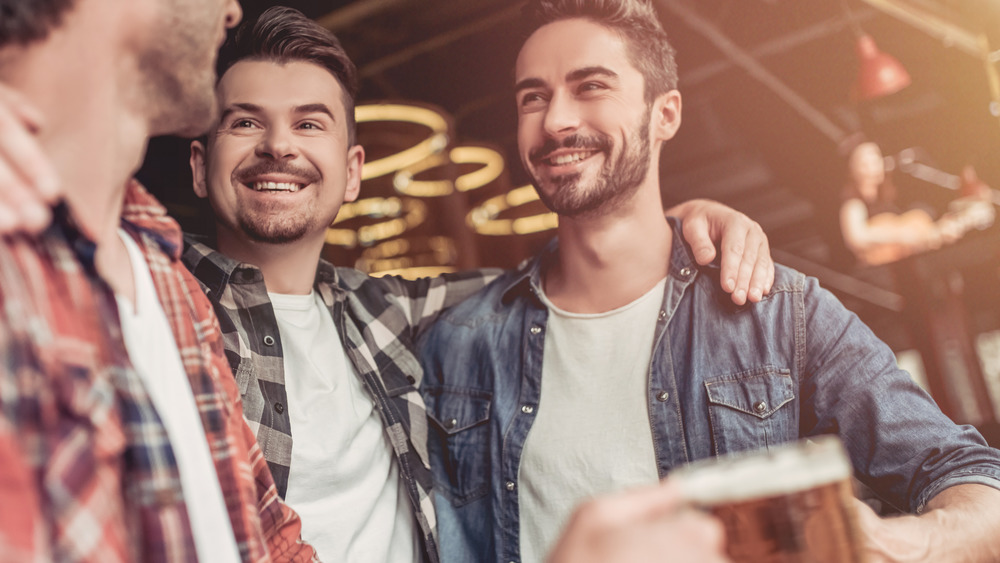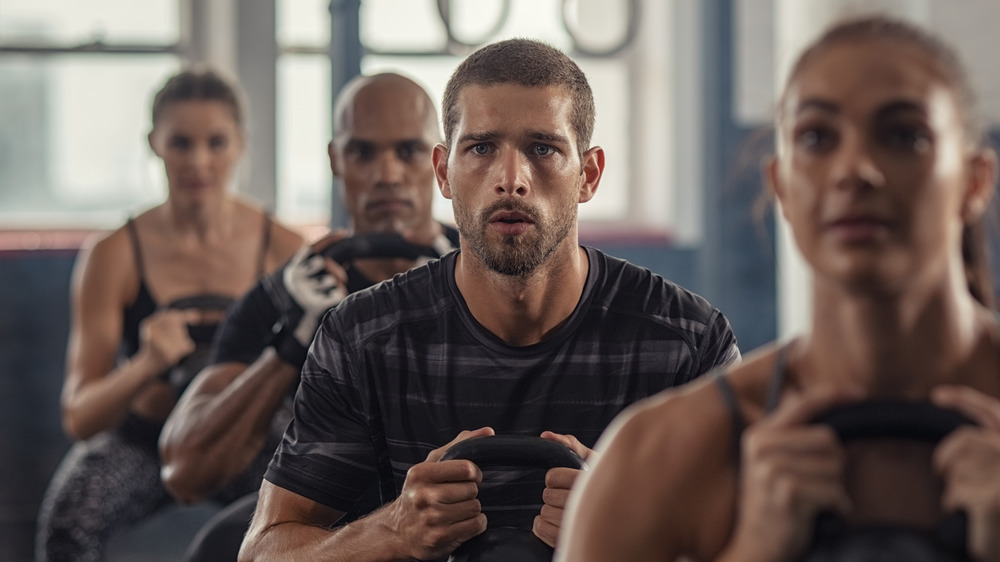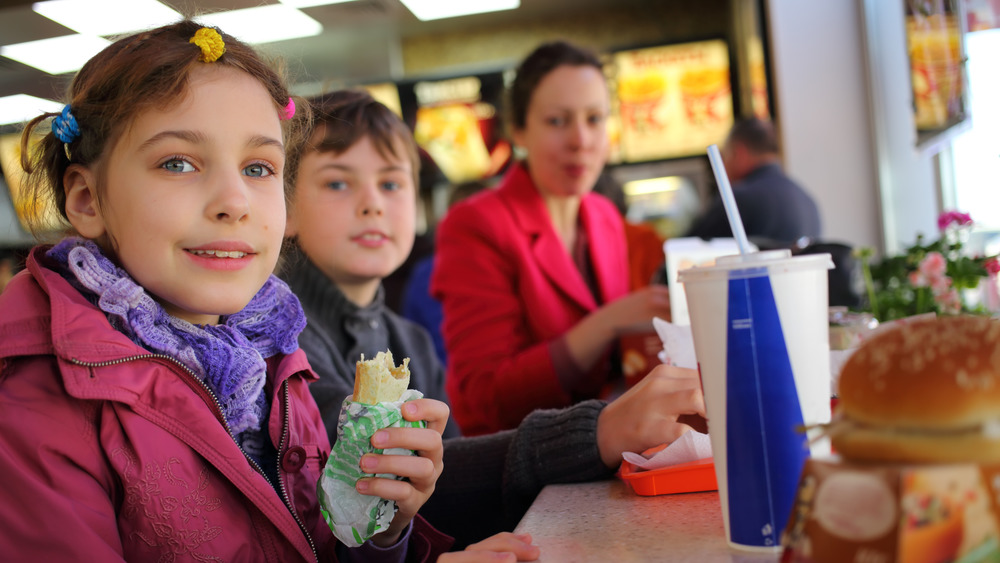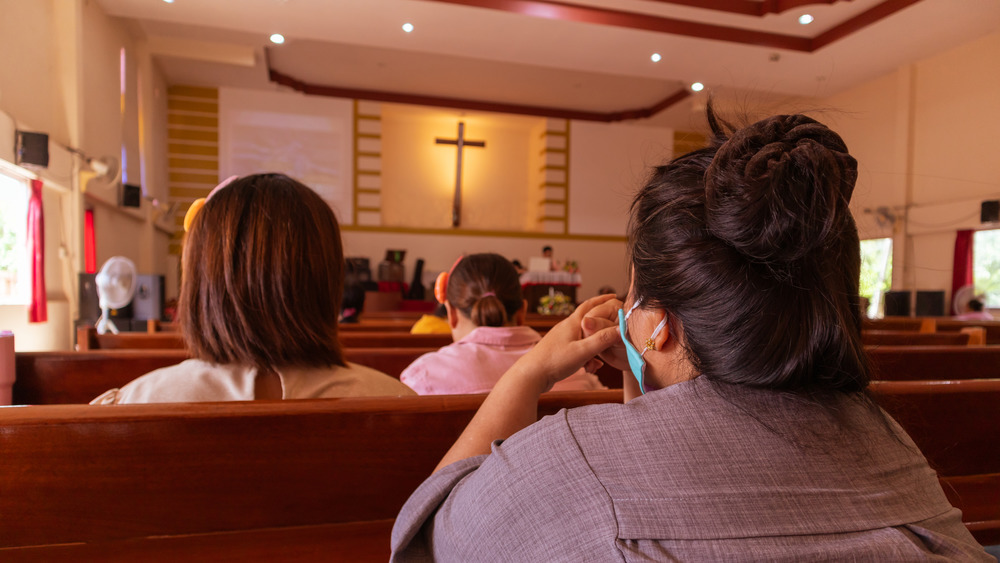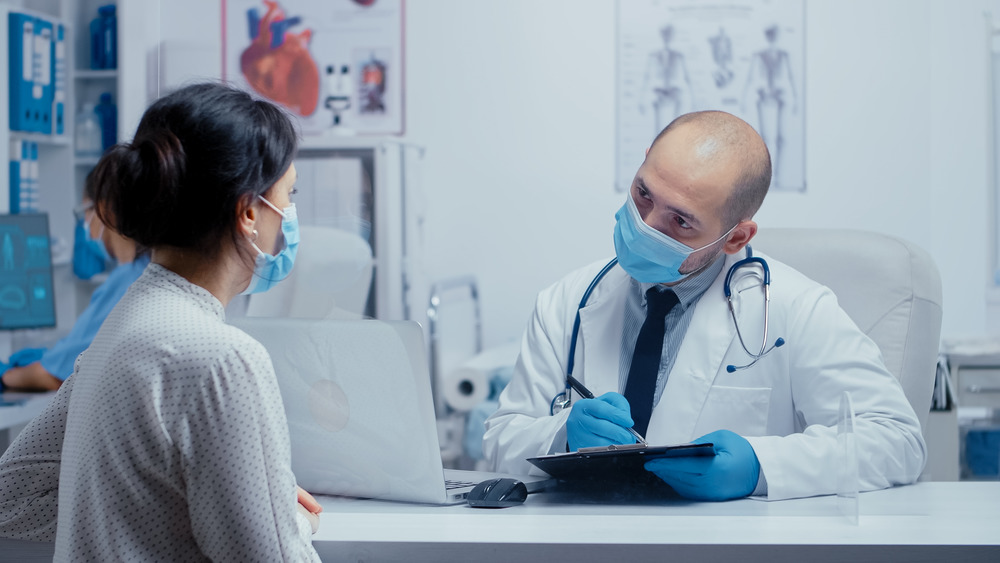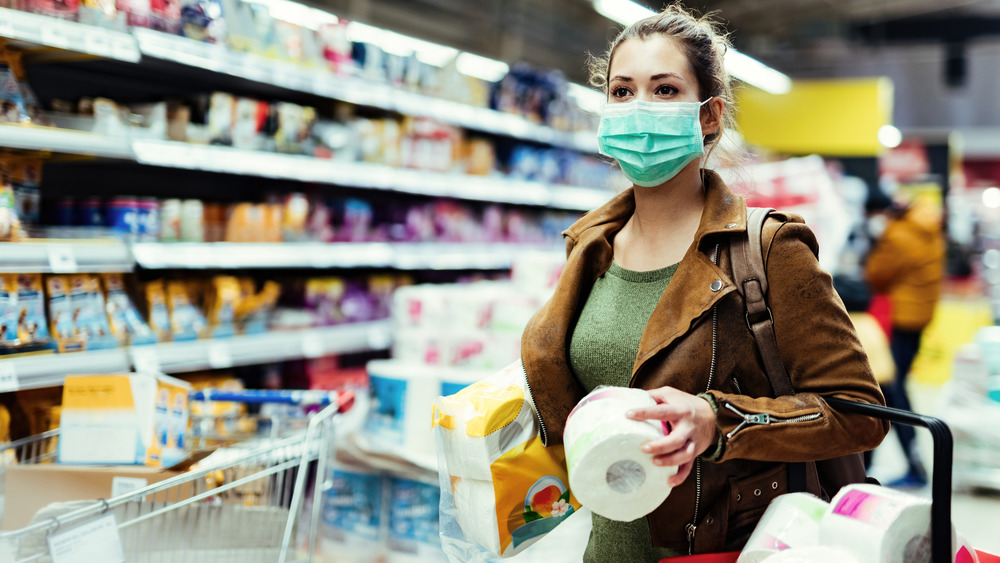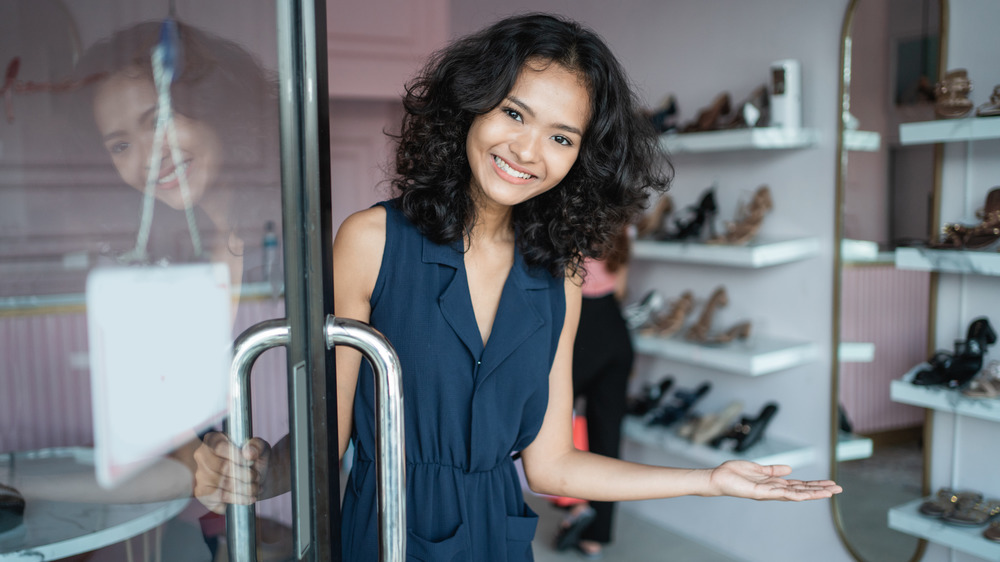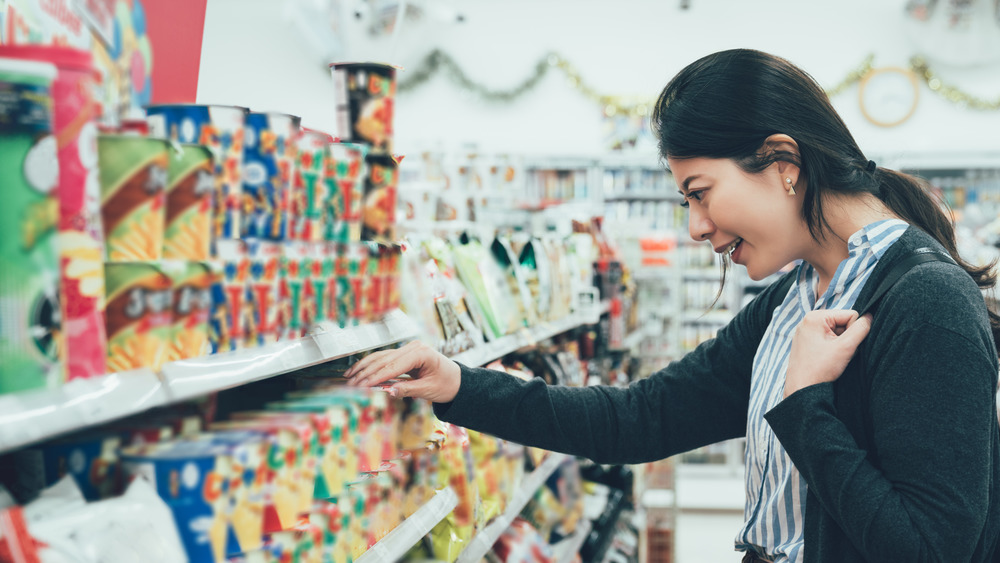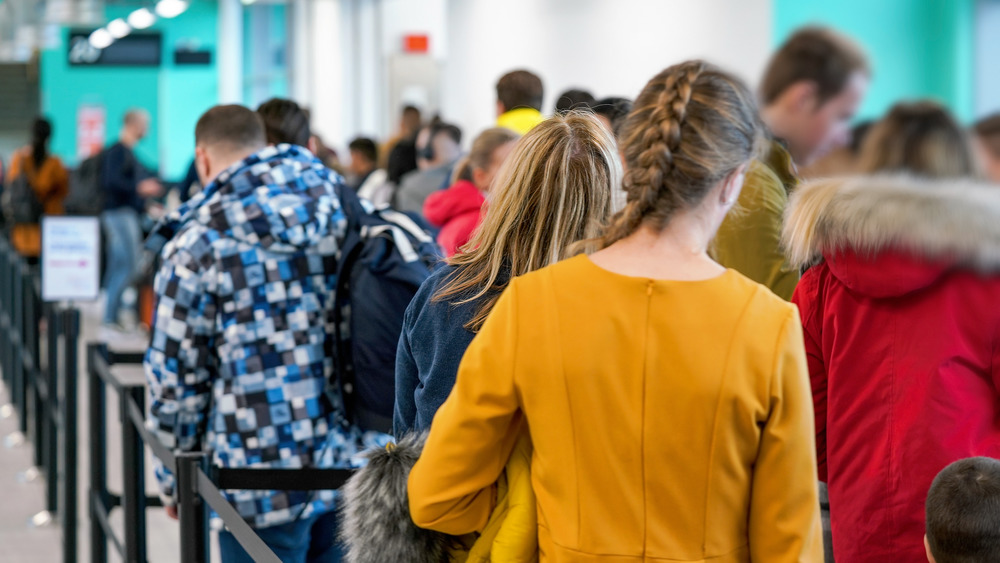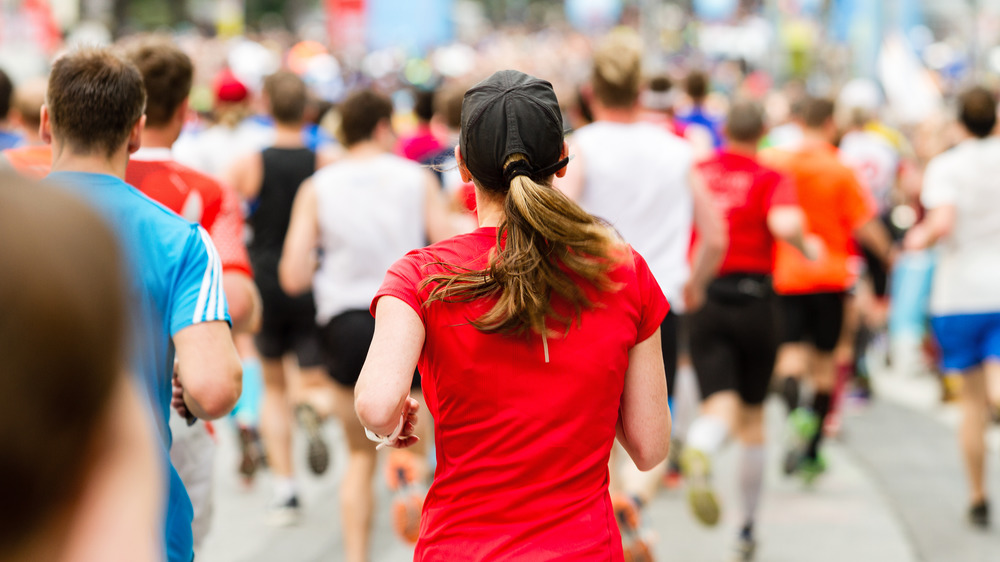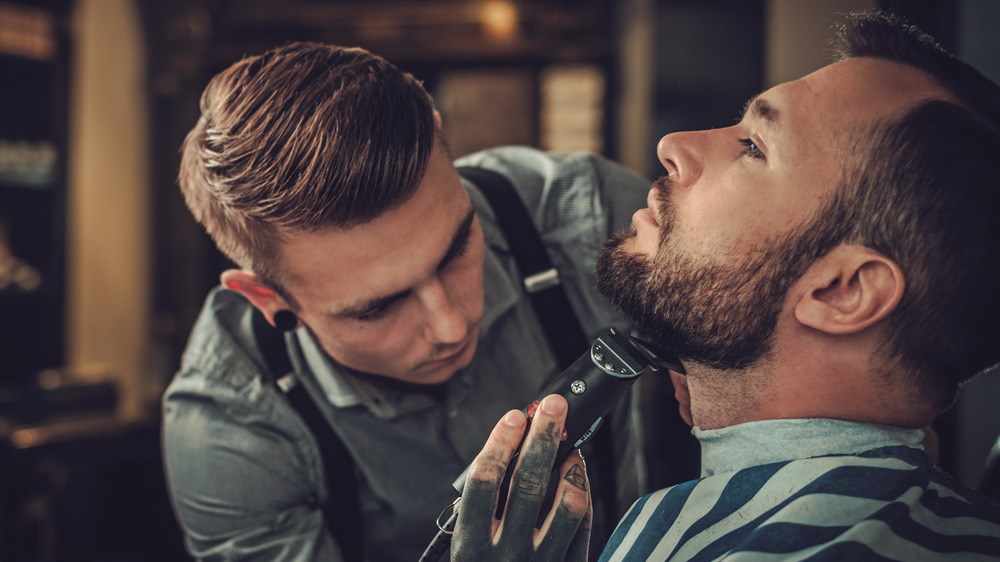These Are The Places You're Most Likely To Catch COVID-19 This Winter
The COVID-19 pandemic has already hijacked the better part of 2020, but many people — including scientists — are especially concerned about the winter months (via Nature). The reason? As the temperature drops and the days grow shorter, more people will be interacting indoors, and often in places with poor ventilation and for extended periods of time. On top of that, college kids are flooding back to their hometowns straight from their crowded dormitories, fraternities, and sororities, where the virus was spreading, often asymptomatically, over the course of the fall semester.
Having long since predicted that as the weather grew colder and the days grew shorter, COVID-19 infection rates would increase significantly, scientists and other experts have been conducting research aimed at identifying those places and situations where the risk of spreading COVID-19 may be highest. Read on to learn the places where you are most likely to catch COVID-19 during the winter.
Dining at full-service restaurants dramatically increases your risk of getting COVID-19
Full-service restaurants (the ones that have servers taking orders and delivering food to tables) are, by far, some of the riskiest places for COVID transmission, according to a study out of Stanford University. The study analyzed the day-to-day movement patterns of 98 million Americans (as reflected in their cellphone GPS data) through a half-million different venues over the course of three months in an effort to determine the types of places that are capable of causing the most COVID-19 infections, if reopened without restriction.
Most infections occur in small places that put many people in contact for extended periods of time, lead study author Serina Yongchen Chang told Health Digest. Ranking among the highest in the study for having the greatest potential to cause the most viral spread were full-service restaurants. And that, said Chang, is due to the sheer number of people involved in providing service to customers and the length of time people tend to stay at full-service restaurants.
Spending time in bars puts you at considerable risk for catching COVID-19
When you make the decision to go to a bar, presumably it's because you want to be around other humans while enjoying an adult beverage. The problem with that in the age of COVID-19 is how difficult it is to keep a safe distance from others. Therefore, it's not surprising that in September 2020, the Centers for Disease Control and Prevention (CDC) reported that adults testing positive are almost twice as likely to have visited a bar prior to infection as those testing negative.
"Bars are really problematic," Dr. Anthony Fauci, head of the National Institutes of Allergies and Infectious Diseases, pointed out in a recent interview with Kaiser Health News. "I have to tell you, if you look at some of the outbreaks that we've seen, it's when people go into bars, crowded bars." In addition, the CDC revealed that using alcohol may alter judgement, making it more difficult to practice COVID-19 safety measures.
You may catch COVID-19 at a private gathering of friends and family
Private gatherings have long been blamed for at least some of the spread of COVID-19. "[In] these innocent family and friends gatherings — six, eight, ten people come together in someone's home — you get one person who's asymptomatic and infected and then all of a sudden, four or five people in that gathering are infected," Dr. Anthony Fauci, head of the National Institutes of Allergies and Infectious Diseases, said in a Q&A with the Journal of the American Medical Association.
To help people make informed decisions about their own private gatherings, Georgia Institute of Technology published a Risk Assessment Planning Tool that can calculate the odds that any private gathering includes a person capable of spreading COVID-19. This is based on the number of people present and the precise location of the gathering. "For example, the chances of a person with COVID-19 being at a 10-person gathering in Fulton County. Georgia, is about 18 percent," explained WUSF Public Media. "If it's 100 people, that chance goes up to 86 percent."
Going to the gym is usually the healthy choice, but the risk of catching COVID-19 makes it questionable
When the weather turns colder, exercising outdoors may not be practical. However, gyms and other fitness centers can have a major impact on the spread of COVID-19, Serina Yongchen Chang, lead author of a comprehensive COVID-19 mobility study, told Health Digest. Fitness centers were identified as a potential "superspreader" site and were estimated, based on the data, that if gyms in Chicago had reopened on May 1, 2020, there would have been an additional 149,000 infections.
This hypothesis has already been supported by real life events. Research published in the scientific journal, Emerging Infectious Diseases found that out of a total of 217 people who attended fitness classes at any of 12 sports facilities in South Korea during early March (before fitness centers were locked down), 54 tested positive for COVID-19, leading to a total of 112 cases.
"Moist, warm air combined with turbulent air flow from exercising may create an environment in which virus droplets can spread readily," according to Healthline. The CDC warned that these droplets are one of the principal means through which COVID-19 is spread.
Your winter getaway could put you at risk for COVID-19
Hotel and motels also fall into the category of high-risk venues identified by a COVID-19 mobility study, along with restaurants and fitness centers and others. The reason, lead study author Serina Yongchen Chang told Health Digest, is the high number of people present and the duration of their stay (presumably overnight at the very least).
The Centers for Disease Control and Prevention advises staying home, but if you do plan to travel overnight, the CDC recommends vetting potential accommodations carefully with respect to COVID-19 prevention practices. That includes calling in advance to determine whether staff members are required to wear masks at work and to find out if contactless check-in, room-entry, and payment are available. You should also inquire as to whether the most up-to-date cleaning and disinfecting policies are in place.
To minimize the risk associated with hotels, the CDC suggests, among other things, always wearing a mask in the lobby and other common areas and taking the stairs rather than the elevator, if possible.
COVID-19 can easily spread in fast food restaurants
Currently, there is no evidence to suggest that COVID-19 is spread by handling or eating food, the Centers for Disease Control and Prevention has reported. However, that does not mean that the risk of COVID-19 spreading as a result of viral droplets is not significant. The CDC's guidelines state that any restaurant offering on-site, indoor dining operating at regular capacity with tables less than 6 feet apart are considered the "highest risk" for COVID-19 transmission. Yes, that means it's not just full-service restaurants you'll want to watch out for. That said, the risk does go down from "highest" to "higher risk" when an on-site restaurant's capacity is limited with tables that are spaced at least 6 feet apart.
What about taking your meal to an outdoor eating area? "On-site dining with outdoor seating, but tables not spaced at least six feet apart" is considered "higher risk," per the CDC. If you're looking for a change of pace from your usual home-kitchen fare, a much safer choice is making use of drive-through, delivery, take-out, and curb-side pickup.
Places of worship present COVID-19 risks, but some can be mitigated
"Millions of Americans embrace worship as an essential part of life," the CDC recognizes. Although gathering at a place of worship presents a risk for spreading COVID-19, it's slightly less than the risk associated with reduced-service restaurants (such as fast food restaurants), according to a COVID-19 mobility study. Lead study author Serina Yongchen Chang explained to Health Digest that the risk can be mitigated depending on the number of people in attendance and length of their stay.
The CDC stated in its "Considerations for Communities of Faith" that the risk of spreading COVID-19 among congregants can be reduced through limiting direct contact with people from outside your household, and wearing a mask.
That being said, in accordance with the First Amendment to the U.S. Constitution, the CDC has made it clear it has no intention of creating standards for interaction among members of faith-based communities in their own houses of worship (unless those standards of interaction are also consistently imposed on similarly situated but non-faith-based communities).
You could catch COVID-19 when visiting your healthcare provider this winter
Perhaps ironically, it turns out that visiting your healthcare provider could contribute to the spread of COVID-19, albeit slightly less so than attending services at your place of worship, according to a COVID-19 mobility study. Of course, the risk associated with visiting any particular healthcare provider will depend upon how many people work in the office, how many people are allowed in the waiting room, how long each person stays, and the cleanliness standards observed by the office staff, among other factors.
The CDC recommends taking advantage of telemedicine options first. When an in-office appointment is unavoidable, though, you should wear a mask, maintain social distancing, avoid touching your eyes, nose, and mouth, and use contactless payment if possible. If you think you might have COVID-19, the CDC recommends notifying your healthcare provider in advance of your visit and following their instructions.
Grocery shopping raises your risk for COVID-19
The fact that grocery stores are essential businesses may have led, in part, to their ranking in the list of places you're most likely to catch COVID-19, a study published in the scientific journal Occupational & Environmental Medicine explained. This may be because store employees spend extended periods of time in an indoor environment in which people who may be carrying the virus, albeit asymptomatically, are touching items with their hands.
In a single grocery store in a Boston, Massachusetts suburb, 21 out of 104 employees tested positive (20 percent) for COVID-19 during a three-day case-study led by Dr. Justin Yang of Harvard T.H. Chan School of Public Health in Boston. Of those who tested positive, virtually all had a job that required direct interaction with customers.
While the study focused on a small number of test subjects, Dr. Yang and his colleagues believe the findings support "policy recommendations that employers and government officials should take actions on implementing preventive strategies" to ensure the health and safety of essential workers. Additionally, the CDC recommends limiting your visits to the grocery store, and ordering your groceries online, if possible.
You risk catching COVID-19 at retail stores during peak holiday shopping times
A comprehensive COVID-19 mobility study established that retail stores present a heightened risk for COVID-19 infection. Although grocery stores are higher up on the list, other stores are not immune. Brick-and-mortar stores often require human-to-human interaction and sometimes for longer than just a moment or two. Such stores include clothing stores, shoe stores, sporting good stores, pet supply stores, and pharmacies.
As lead study author Serina Yongchen Chang pointed out to Health Digest, this is consistent with the pattern established by the study, which is that longer dwell times are associated with higher transmission risk. While shopping local can support both the local and global economy, the CDC recommends avoiding shopping in crowded stores at their most crowded times (for example, just before, on, or after a major holiday like Thanksgiving or Black Friday). The CDC lists such an activity as "higher risk." To be safe, opt for "lower risk" shopping, like "shopping online rather than in person" on crowded days.
Stopping in at a convenience store can increase your risk for COVID-19
When it comes to ranking retail establishments for COVID-19 transmission risk, gas stations, convenience stores, and other quick-stop type retailers are toward the bottom, Serina Yongchen Chang, lead study author of a COVID-19 mobility study, told Health Digest. That means your likelihood of catching COVID-19 while buying gas or picking up a carton of milk is still elevated compared to just staying home, but not as high as spending time at many other retail locations.
In assessing risk, the study model considers "square footage of the store, crowd density, and how long customers tend to stay at the store," Chang's advisor and the computer scientist who led the modeling efforts for the study, Jure Leskovec, explained to Health Digest. Because people tend to spend less time in quick-stop type stores than they do in, say, pet stores, Dr. Leskovec clarified, the risk is going to be lower.
If you take public transportation this winter, you'll be more likely to catch COVID-19
The risks of any kind of travel are significant, according to the CDC. This is certainly true of public transportation. "Staying home is the best way to protect yourself and others from COVID-19," the CDC has advised, adding "You may feel well and not have any symptoms, but you can still spread COVID-19 to others." This includes your family, friends, and community for some 14 days after you were exposed to the virus — even if you have no symptoms.
In addition, public transportation requires you to spend an extended period of time in an enclosed space with people from outside of your household. Although viruses don't spread more easily on airplanes thanks to circulating and filtered air, air travel does require standing in security lines and in crowded airport terminals. As such, this can bring you into close contact with other people and frequently touched surfaces, the CDC explained.
Events and gatherings held outdoors present some risk of COVID-19 transmission
If you're lucky enough to live in a warmer climate, you may be able to continue spending time outside through the winter months. However, you shouldn't assume that since outdoor spaces permit better air flow that they'll automatically present no risk.
The fact is: Your risk of catching COVID-19 is elevated when you attend outdoor events and other gatherings, which the CDC defines broadly as any event taking place outside, whether spontaneous or planned, involving any number of people. As Dr. Amesh Adalja, an infectious disease expert at Johns Hopkins Center for Health Security, told Reuters, "It's not a major stretch" to say that large unmasked gatherings can spread coronavirus.
In evaluating the risk of spreading or catching COVID-19 at any particular outdoor gathering, the CDC explained, "The more people an individual interacts with at a gathering and the longer that interaction lasts, the higher the potential risk of becoming infected with COVID-19 and COVID-19 spreading." Therefore, Georgia Tech's Risk Assessment Planning Tool may be helpful in calculating your risk for COVID-19 transmission at any outdoor gathering you're considering attending this winter.
Getting your nails done or your hair cut could leave you with COVID-19 this winter
Hair salons, nail salons, barbershops, and the like present an increased risk for catching and spreading COVID-19. It's true that systematic use of face masks at beauty salons has been associated with a much lower risk of COVID-19 transmission — even when one of the service providers turns out to be carrying the virus — according to a small case study conducted in Missouri in August 2020.
However, a lax policy on face masks could turn your go-to salon into a superspreader site. Plus, there are a variety of circumstances in which a face mask would not be possible in a salon, particularly in salons catering to male grooming.
In a November 2020 interview with The New York Times, Dr. Anthony Fauci, head of the National Institutes of Allergies and Infectious Diseases, stated that he still regards such places as risky. "I used to get a haircut every five weeks," he stated. "I get a haircut every 12 weeks now. With a mask on me as well as a mask on the person who's cutting the hair, for sure."

